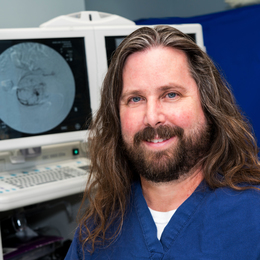
Back in the Flow
At Main Line Vascular Institute, Dr. Edward K. Pavillard offers minimally invasive solutions to circulatory conditions of every sort, from the simple to the complex.
Within the intricate mosaic known as the human body, the circulatory system may be among the most complex—a highway of blood vessels that snakes through the body, from head to toe. Like any highway, the system sometimes experiences problems and disruptions to the traffic flow—in this case, the flow of blood throughout the body.
In the Greater Philadelphia Area, individuals have an invaluable resource in the form of Main Line Vascular Institute, a state-of-the-art outpatient facility based in King of Prussia. There, a team of board-certified physicians offers a number of solutions to conditions related to the circulatory system, from the simple to the complex, and from cosmetic issues to potential threats to life and limb.
Peripheral arterial disease, or PAD, is a common circulatory problem treated by Main Line Vascular Institute. PAD results from arteries that have been narrowed or blocked by the buildup of plaque, which reduces blood flow to the limbs, thereby causing significant pain and affecting mobility. While genetics may predispose an individual to PAD, factors such as heart disease, diabetes, a sedentary lifestyle, and smoking may increase someone’s risk of developing the condition. If PAD worsens to advanced stages, potentially life-threatening health problems may follow.
“It’s called critical limb ischemia, where the patient has such low blood flow that the tissue on the feet and the toes will start to die,” says Edward K. Pavillard, D.O., a board-certified vascular surgeon with Main Line Vascular Institute who specializes in minimally invasive procedures for the treatment of arterial and venous disease. “In the earlier stages, it can result in non-healing wounds, which may prevent people from walking. The more advanced it becomes, people can’t do much of anything, and that sets off a cascade of other issues.”
Main Line Vascular Institute offers a number of treatments to help patients with PAD, including angioplasty and stenting to maintain the opening of the blood vessels, and plaque-shaving devices to increase blood flow to the affected areas. Once patients are treated for the condition, Dr. Pavillard says they “almost immediately” feel better.
Dr. Pavillard has a particular interest in utilizing cutting-edge technology to advance the treatment of PAD. He is a proponent of Optical Coherence Tomography (OCT), a noninvasive imaging technology that enables him to have an intra-lumen (inside the vessel) view without resorting to X-rays, which promote radiation, or contrast dyes, to which some patients have an allergy. In addition, he is personally involved with the development of endovascular devices designed to expand the treatments available for the condition.
For example, Dr. Pavillard is involved with clinical trials of the Shockwave Medical lithotripsy system, which has been used to treat calcified plaque in PAD patients. In addition, he is the primary investigator for two active trials in the United States that are being performed by high-volume OCT users to extend the indications for the use of intra-lumen imaging. Dr. Pavillard says Main Line Vascular Institute will be the only outpatient facility in the Northeast to offer such revolutionary treatments.
“Our facility offers advanced imaging and interventional equipment to effectively treat many conditions associated with the circulatory system,” he says. “While many of the procedures we offer are covered by insurance, and most of the treatments we perform here are performed minimally invasively. If something is affecting your quality of life, there’s no need to ignore it or procrastinate in getting the problem addressed.”
Main Line Vascular Institute
700 S. Henderson Ave., Suite 225
King of Prussia, Pa.
Photography by Jody Robinson


